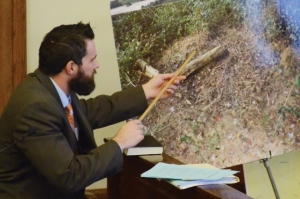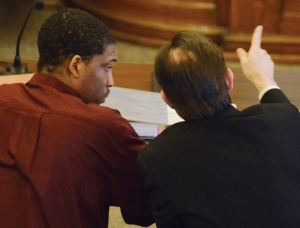Testimony continues in Joyner murder trial
By Kenneth Fine
Published in News on March 21, 2014 1:46 PM

News-Argus/CASEY MOZINGO
SBI agent Justin Godwin points to a map showing the area where the body of Kennedy McLaurin was found. Godwin testified Thursday in Wayne County Superior Court in the murder trial of Leonard Eugene Joyner.

News-Argus/CASEY MOZINGO
Leonard Joyner confers with his attorney, Charles Gurley, during Thursday's proceedngs.
Testimony in the murder case against Leonard Eugene Joyner Thursday turned to the day when investigators got the answer to the question, "Where is Kennedy McLaurin?"
North Carolina State Bureau of Investigation Agent Justin Godwin described the discovery of the 16-year-old's body in a Wayne County field.
He said it was clear, after a few moments working at "the grave," that he would uncover human remains before his work was through.
"At some point, I smelled a strong odor of decomposition," he said. "The more we dig, the stronger it gets. I know ... yes, we have a body here."
Joyner is the last of four men to be charged in connection with the death of the Goldsboro High School student and faces counts of first-degree murder and first-degree kidnapping.
And while the majority of the testimony delivered centered on several crime scenes, it was Godwin's account of how he discovered the teenager's remains in a wooded area that drew the most visible response from those seated on the other side of the bench.
The agent told the court that he became involved with the McLaurin case on Sept. 20, 2012, when the Goldsboro Police Department requested his assistance at a crime scene -- a field off Carmack Road some 500 feet from where, two days later, he would unearth the remains of the young man who went missing earlier that month.
But the charred blue jeans, socks, bullet and shell casing he found in and around the "first burial site" was not his most significant discovery as a member of the investigation team.
That would not come until Sept. 22 -- the day he was charged with exhuming, using his hands, a sifter and a shovel, a body he characterized as severely decomposed.
"The victim was kind of positioned on his side," Godwin said.
The following testimony was also delivered Thursday:
State witness No. 10: Goldsboro Police Department crime scene specialist Cpl. Steven Powers -- Powers, who testified earlier in the trial, took the stand for a second time and detailed, for the court, his involvement at several different crime scenes associated with the McLaurin case.
He testified that he was among the members of the Goldsboro Police Department called on to respond to a field off Carmack Road at around 6 p.m. Sept. 20, 2012, 11 days after the 16-year-old disappeared.
As soon as he arrived, Powers said he started taking pictures -- landscape shots from different views and angles -- before breaking out a metal detector and beginning to sweep the grounds. The officer told the court that he had "some hits" with the device and that GPD Det. Dwayne Bevell pointed out several "visible" pieces of evidence.
For roughly the next hour, his testimony involved describing many of the photographs he had taken to the jury -- to familiarize them with the crime scene he characterized as "the burial site." He then talked about a particular spot that was later identified as a "burn pit" -- the area that became a focal point of the investigation. Powers showed several photos of "an indention in the dirt" and the "burial site" to the jury and explained what evidence his fellow officers found buried within it. Among the images he described were "a shot of charred remains of a piece of wood," a picture of "debris," several of "the hole" and one of an officer digging.
"There appeared to be something in the hole, so I kept taking pictures," he said. Powers then testified that there were, in fact, several pieces of evidence in the hole -- among them a "partial shoe," several "pieces of jeans" that appeared to have been burned and a piece of cardboard that was "covering the area."
Powers then talked about a previous crime scene -- the one on Deluxe Drive where the car McLaurin allegedly died in was found -- and how officers "scoured" the vehicle and found "nothing at all."
During cross-examination, defense attorney Charles Gurley asked Powers if there would be bullet holes in the car, given the fact that two bullets were recovered from McLaurin's body. The officer said there would not be. Powers also, in response to a question from Gurley, said he did not participate in the video recording of suspect interviews and had "no idea" about particular claims made by the four men arrested for their alleged role in McLaurin's death. The officer, when asked if he had any contact with the suspects, said he did not. And when Gurley asked him repeatedly if he put his name on two DVDs, he said he did not. The defense attorney also pressed Powers on a time gap in his report. "Can you explain to the jury why your report goes from Sept. 20 and then nothing else is mentioned until Sept. 25?" Gurley asked. "Yes sir," Powers replied, adding that he was out of town at a conference during that time.
State witness No. 11: North Carolina State Bureau of Investigation Agent Justin Godwin -- Godwin told the court that he became involved in the McLaurin case Sept. 20, 2012 -- when he was asked to assist the Goldsboro Police Department at "the first burial site," located off Carmack Road. He said he came to town from the Wilson area.
Using an over-sized photograph provided by Assistant District Attorney Matthew Delbridge, Godwin identified the crime scene and said when he arrived there, local lawmen from the GPD and Wayne County Sheriff's Office were already there. He parked his car and was briefed on "information I don't know yet," and got to work -- knowing that daylight was fading. Those working the scene started putting down markers next to potential pieces of evidence and looked for more.
"Everybody comes together to figure out how you want to approach this," he said. The investigators identified an area of interest -- the hole Powers testified about before Godwin took the stand. So he used a shovel, sifter and his hands -- wearing gloves -- and started digging. "You want to be very careful," Godwin said. "For one, you don't know what might be in there. And you don't want to disturb the evidence."
And as he began digging, he smelled something he "thought was gas." Now believing something had been burned inside the hole, Godwin said he took even more precautions to ensure no delicate evidence would be compromised. And he took a soil sample to test for gasoline.
Moments later, he and the rest of the investigators determined it was too dark to continue and, after ensuring local law enforcement would guard the site overnight, Godwin said he went home.
"We came back the next day," he said. "Resumed our search." He told the court they focused on "the burn pit," but also expanded their search area. They located a comb and a pair of socks in the hole, but Godwin "did not believe there was (a body) there." Once they reached the point where "the pit didn't go any deeper," they abandoned their search for the body at that site, Godwin said. But they found more blue jean fabric and a shell casing. "That shell casing would be a 9 mm," Godwin said. "It was close to 10 feet from the center of that burn pit." Other pieces of evidence were collected before he arrived -- a 9 mm live round, a cigar wrapper, a cigar tip and a lighter, the agent said.
And he also testified that a K-9 was called in to attempt to locate McLaurin's body. "The K-9 started at the burn pit," Godwin said, adding that the dog could have picked up a scent from the pieces of clothing or the comb. "The dog did go into the wooded area where the body was (later) found," he said. But at the time, they did not know where the body was, so, at that point, "our search stopped."
After that, Godwin said he felt the only way they would have another crime scene was if somebody with knowledge of McLaurin's whereabouts started to cooperate with the police. "We had done all we could do at that point at the area," he said.
But later that evening, he was notified that investigators had "another area" of interest -- the presumed location of the body. Godwin told the court that the next morning -- they did not search the location that night because it was "a wooded area" with "tough" lighting conditions -- he traveled to the scene. It, too, was located off Carmack Road -- just 500 feet away from the "burn pit" he had investigated the day before.
Godwin, using a long wooden stick, pointed to an over-sized photograph provided by Delbridge to show the jury where they were focusing that day. "It would be hard to know what you were looking at if someone didn't show you," he said, adding that to the naked eye, it did not appear to be a grave. "Not to me it didn't," he said.
Godwin told the court that he decided where to dig based on what earth looked disturbed vs. what did not. Then, he "slowly and methodically" started removing the soil -- sifting through it as he went along to try to uncover evidence. "At some point, I smelled a strong odor of decomposition," he said. They still moved slowly, Godwin said, to ensure they were doing minimal damage to the teenager's remains.
After receiving the OK from the Chief Medical Examiner's Office in Chapel Hill to remove the body from the "grave," Godwin and the other investigators decided to do it "ourselves" rather than use a machine
Godwin said the grave was roughly one-and-a-half feet deep, two feet wide and more than five feet long. After hours of work, the remains were removed from the hole and handed over to EMS officials.
During cross-examination, defense attorney Charles Gurley handed Godwin a diagram and asked him several questions about it -- some that the agent said he could not answer because he was not the one who drew it. And Gurley asked him if he was the one who found the shell casing -- Godwin said he did -- and how many feet he dug at the "first burial site." "It was fairly shallow," the agent replied. Gurley concluded his brief cross-examination by asking Godwin if the hole at the first site off Carmack Road was big enough for a body and the agent said he could not answer the question.
Editor's note: The state also called witness No. 12, Goldsboro Police Department crime scene investigator Cpl. Trevor Albaugh, to the stand Thursday, but the officer did not complete his testimony. For a detailed recap of what he told the court, see Sunday's News-Argus or go to www.NewsArgus.com and click on our "Live from the courtroom" coverage from Thursday and today.
